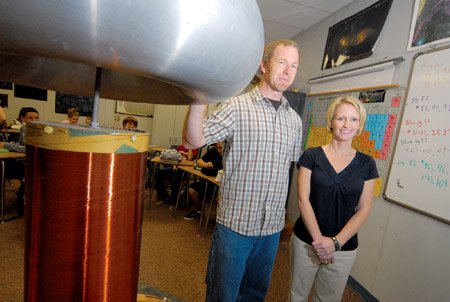RIVER VALLEY and OZARK AREA — Mount Vernon-Enola High School science teachers Terry Johnson and Judith Putnam are joining forces to help their students better understand the world of science.
Johnson, who has been a teacher in the Mount Vernon-Enola School District for three years, teaches physical science courses such as chemistry and physics; he also teaches mathematics. Putnam, who has been with the local school district for eight years, teaches life science courses, such as biology and anatomy.
“These two sciences don’t normally go together,” Johnson said. “They are very separate, both in the way they are presented and by the type of student that will take them.
“This year, we are trying to apply as much of one content to the other as we can in an attempt to hit as many students as we can,” he said. “Maybe one student thinks he or she will excel in one science and not so well in the other. We want to show there are similarities in both sciences.”
Johnson said the two teachers are also encouraging students to participate in more research projects.
“I’m really passionate about that,” he said.
Johnson said physical science “is very math-heavy. Life science is more memorization, more association. I’ve never tried relating the two before.”
The local teachers are involved in a program funded by a grant through the University of Central Arkansas. Umadevi Garimella, director of the Arkansas Center for Mathematics and Science Education at UCA, received a grant for $110,842 by the Arkansas Department of Education for the Science Lead Teacher Institute.
“We went to workshops at UCA this past summer where they gave us ideas for conducting labs involving both fields,” Johnson said. “About a dozen schools in the area are involved.
I learned a lot. I enjoyed it. I’ve never taught life science. I don’t know much about it.” Putnam said the workshop at UCA “was one of the best workshops I’ve been to.
“Mr. (Rudy) Beavers (high school principal) said this was something we needed to do,” she said. “I was so pleased that we found some labs we could bring back to the school to tie physical science and life science together. It’s a great learning opportunity.” In addition to having their fees for the workshop paid through this grant, Johnson said the school also received a “nice box of lab equipment” for par- in the Johnson said one lab the two teachers will hold concerns the speed of sound.
“That’s a pure physical science topic,” he said. “But I’ll incorporate a second component and discuss how sound is processed in the human ear, which is a life science concept.” Putnam said she would do a similar lab in biology.
“He’ll show how sound is propagated through a medium, and I’ll relate it to the human ear,” she said.
That lab is scheduled for January.
Beavers said he is glad his teachers attended the workshop and are now practicing some of the skills they learned.
“This is a new initiative; they just started it this year,” Beavers said. “I was a little hesitant about sending them at first. But when they came back bragging about it and saying how useful it will be to them, I was glad they attended.
“These teachers have to get so many hours of in-service for professional development. They are always looking for workshops to attend.” - crolf@arkansasonline.com
River Valley Ozark, Pages 68 on 10/08/2009
